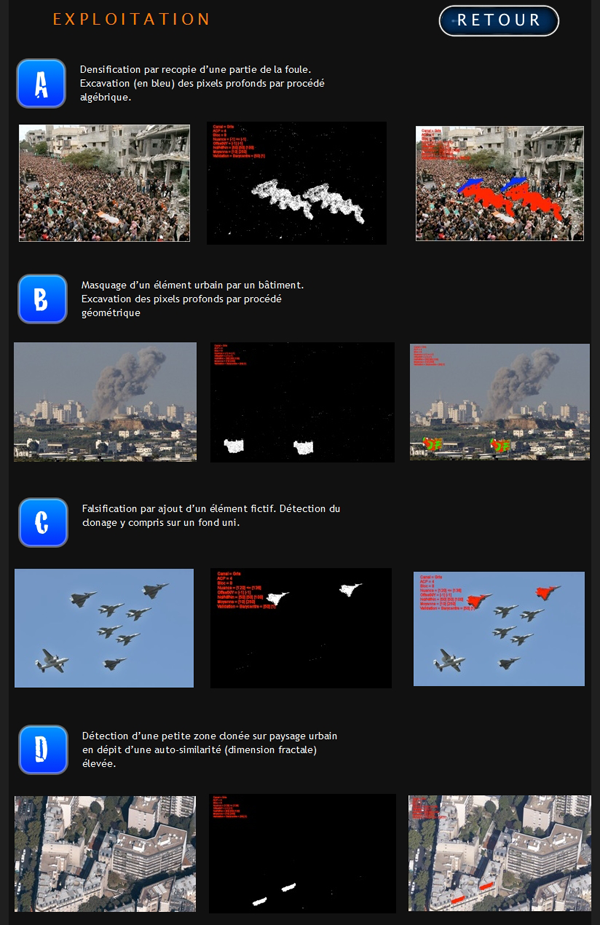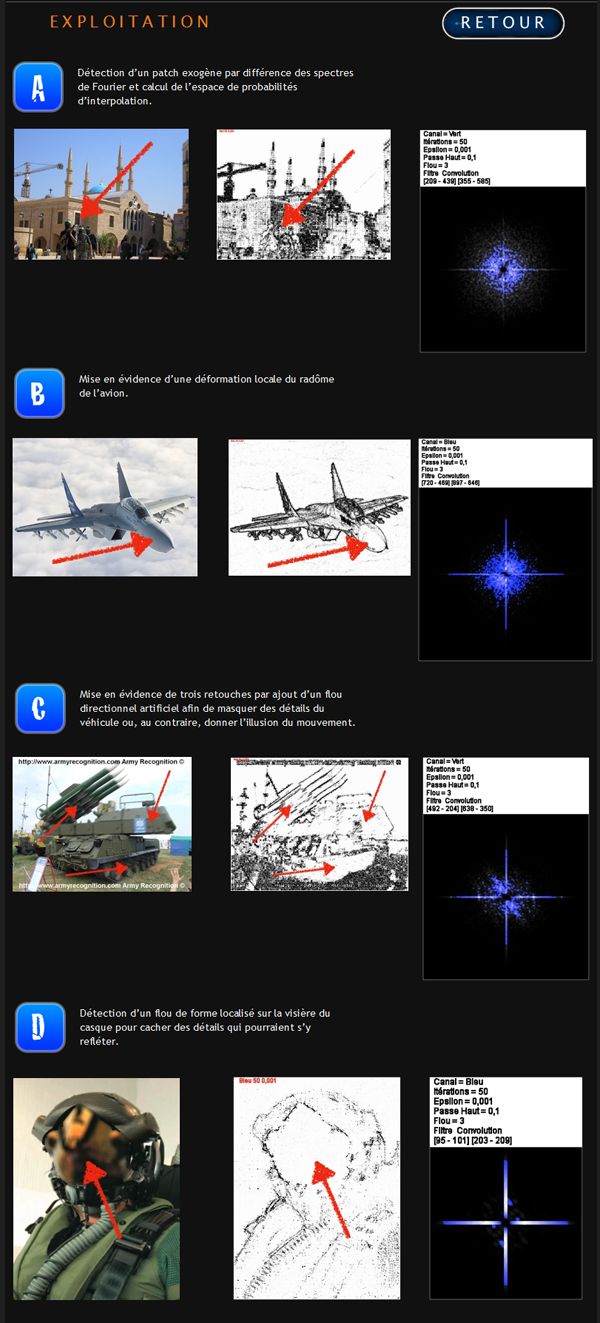Tungstene recognizes Photoshop
At the end of May, a message passed on a number of European web resources, which has not really reached the Runet yet. On blogs, gossiped, twirled your finger at your temple, chatted about this and that, and they went away.
Nevertheless, the development of the Frenchman Roger Cozien (Roger Kozien), the doctor of mathematics, the criminologist and the founder of the Exo Makina digital expertise society, has sufficient potential value to be examined in more detail.
Meet Tungstene or "Wolfram." Without the “e” at the end of the English spelling - anti-photoshop and “death to gloss,” as some particularly impressionable photobloggers dubbed it.
What is "Wolfram"? According to the author, the program allows you to determine the digital correction of photos and images, that is, in simple language, photoshop. It was developed by Roger, together with other researchers, upon the order of the French Ministry of Defense (Le ministère de la Défense Nationale).
')
Surprised to be such a customer or not - you decide yourself, I am of the opinion that the fact is interesting, but quite natural - the interests of national defense require the solution of such tasks as identifying the mounted photos.
Tungstene was presented to the public at the National Assembly on May 26 (l'Assemblée nationale, lower house of the French parliament). This is remarkable, especially since Petrikov did not seem to be following the French.
Obviously not based on EXIFs. On the Exo Makina website there are several examples of the work of Wolfram, albeit dated, roughly, by the end of 2009, when the development was not yet completed.
Pictures are uploaded to habreffect.ru, links to the original pages are given.
On each of the pages of the links there are more clarifications about the principles of operation of each algorithm.
Cloning
www.exomakina.fr/eXo_maKina/Clonage.html
Summary: The same pixels are determined.

"Pasting" (Exogene)
www.exomakina.fr/eXo_maKina/Exogene.html
Summary: photomontage, "gluing" of new parts, extended cloning.

Retouch
www.exomakina.fr/eXo_maKina/Mosaique.html
Summary: contour deformation, endogenous change tracking (internal, without adding new elements).

Edit
www.exomakina.fr/eXo_maKina/Q2.html
Summary: The very fact of interfering with a photo is determined (not necessarily related to semantic distortion).

The site contains the following description of “Wolfram” (I’m not strong in French, I used a translator):
TUNGSTEN contains a set of filters and functions that allow the operator to find inconsistencies and changes that fall into two main categories. First, the gaps in the statistics underlying the digital image. Secondly, the contradictions in the laws of physics (scattering of light, rays, color distortions, etc.).
(It is added that in the future there will be functions for determining electronic noise, brightness disturbances, etc. Apparently this is in the version that was presented to the Assembly, but this is my guess).
And then - the practical implementation of the law on the restriction or prohibition of the use of "photoshop", for example, in advertising images, as has already been done in France and the UK. The experience of such "strong" in the legislative initiatives of countries is likely to be taken over by the rest of the EU.
Until now, there were no tools to implement these laws, while the fine, for example, for using the processed photo without a corresponding explanation, in France is € 37,500.
What conclusions will magazines make for themselves? Not yet known. Wolfram, at least, can speed up this process.
Nevertheless, the development of the Frenchman Roger Cozien (Roger Kozien), the doctor of mathematics, the criminologist and the founder of the Exo Makina digital expertise society, has sufficient potential value to be examined in more detail.
Meet Tungstene or "Wolfram." Without the “e” at the end of the English spelling - anti-photoshop and “death to gloss,” as some particularly impressionable photobloggers dubbed it.
What is "Wolfram"
What is "Wolfram"? According to the author, the program allows you to determine the digital correction of photos and images, that is, in simple language, photoshop. It was developed by Roger, together with other researchers, upon the order of the French Ministry of Defense (Le ministère de la Défense Nationale).
')
Surprised to be such a customer or not - you decide yourself, I am of the opinion that the fact is interesting, but quite natural - the interests of national defense require the solution of such tasks as identifying the mounted photos.
Tungstene was presented to the public at the National Assembly on May 26 (l'Assemblée nationale, lower house of the French parliament). This is remarkable, especially since Petrikov did not seem to be following the French.
How it works
Obviously not based on EXIFs. On the Exo Makina website there are several examples of the work of Wolfram, albeit dated, roughly, by the end of 2009, when the development was not yet completed.
Pictures are uploaded to habreffect.ru, links to the original pages are given.
On each of the pages of the links there are more clarifications about the principles of operation of each algorithm.
Cloning
www.exomakina.fr/eXo_maKina/Clonage.html
Summary: The same pixels are determined.

"Pasting" (Exogene)
www.exomakina.fr/eXo_maKina/Exogene.html
Summary: photomontage, "gluing" of new parts, extended cloning.

Retouch
www.exomakina.fr/eXo_maKina/Mosaique.html
Summary: contour deformation, endogenous change tracking (internal, without adding new elements).

Edit
www.exomakina.fr/eXo_maKina/Q2.html
Summary: The very fact of interfering with a photo is determined (not necessarily related to semantic distortion).

The site contains the following description of “Wolfram” (I’m not strong in French, I used a translator):
TUNGSTEN contains a set of filters and functions that allow the operator to find inconsistencies and changes that fall into two main categories. First, the gaps in the statistics underlying the digital image. Secondly, the contradictions in the laws of physics (scattering of light, rays, color distortions, etc.).
(It is added that in the future there will be functions for determining electronic noise, brightness disturbances, etc. Apparently this is in the version that was presented to the Assembly, but this is my guess).
What's next?
And then - the practical implementation of the law on the restriction or prohibition of the use of "photoshop", for example, in advertising images, as has already been done in France and the UK. The experience of such "strong" in the legislative initiatives of countries is likely to be taken over by the rest of the EU.
Until now, there were no tools to implement these laws, while the fine, for example, for using the processed photo without a corresponding explanation, in France is € 37,500.
What conclusions will magazines make for themselves? Not yet known. Wolfram, at least, can speed up this process.
Source: https://habr.com/ru/post/95938/
All Articles